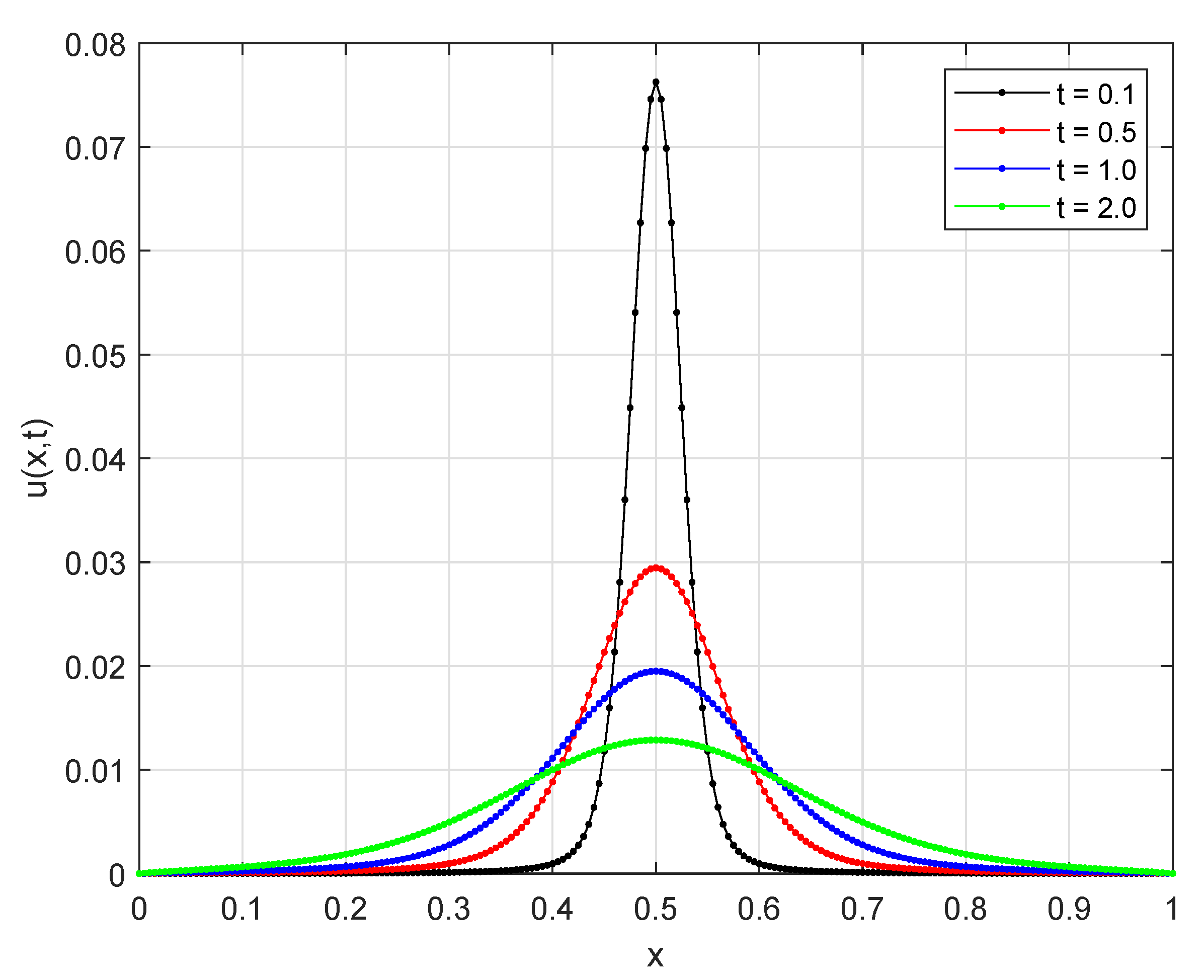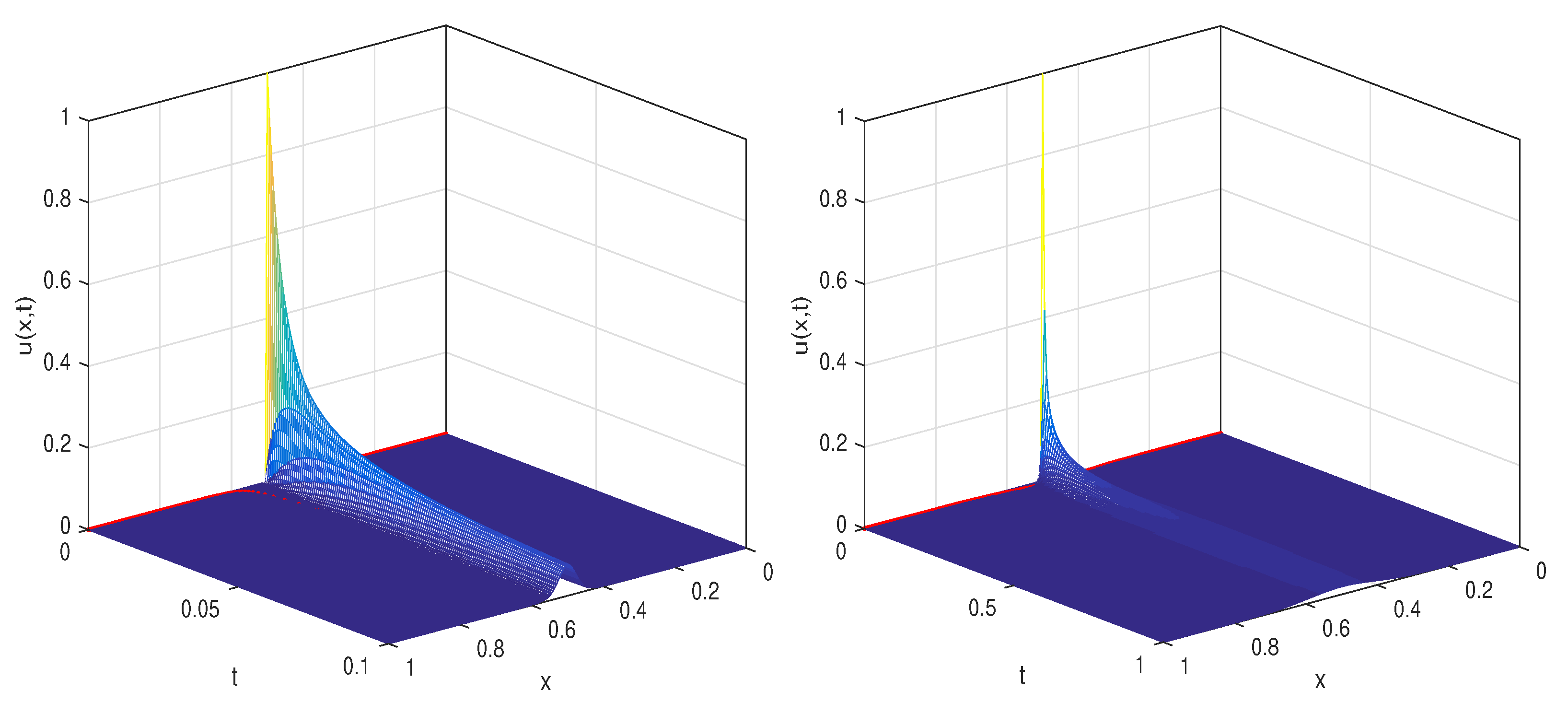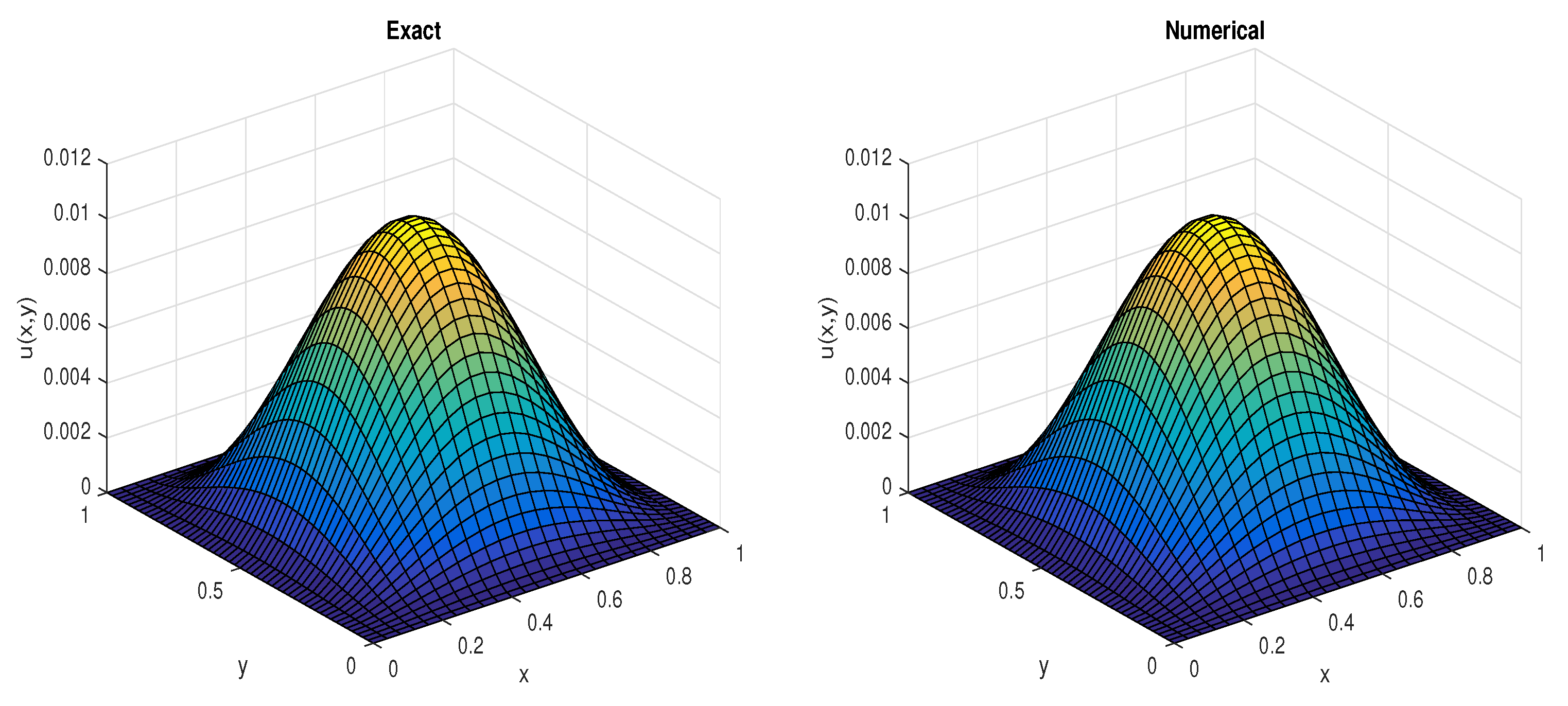1. Introduction
Complex processes which obey a mixture of power laws and flexible variations in space are modeled by distributed-order, space-fractional differential equations. Distributed-order, space-fractional differential equations are used to model the phenomena where the order of differentiation varies in a given range [
1,
2]. Due to their nonlocal properties, the distributed-order differentials can model more complex dynamical systems than the fractional-order or classical models.
Consider the following two-dimensional Riesz-space, distributed-order, fractional, inhomogeneous diffusion equation:
with initial condition
and boundary condition
where
. The coefficients
P and
Q are non-negative functions defined on
, that are not identically zero and satisfy
The inhomogeneous source term
f is assumed to be sufficiently smooth. The distributed-order, space-fractional derivative terms are approximated using Simpson’s three-eighth rule. For any
, the two-sided, Riesz-space-fractional derivative operator
on a finite interval
is given by
where
is the left Riemann–Liouville and
is the right Riemann–Liouville fractional derivatives, which are, respectively,
The Riesz-space-fractional derivative operator on is defined similarly.
A recent review article [
3] provided a state-of-the-art introduction to the mathematics of distributed-order fractional calculus, along with analytical and numerical methods. An extensive overview of the applications of distributed-order fractional calculus with applications to viscoelasticity, transport processes, and control theory have been discussed.
Anomalous diffusion phenomena take place in many complex systems, such as subsurface flows, human tissues, viscoelastic material, and plasma. In such systems, the diffusion is slower or faster than normal, the probability density function is not anymore Gaussian, and the mean-square displacement is not linear in time; see, for example, [
4] and references therein. As such, the predictions obtained through integer-order local models do not match the collected data and observed behaviors. Riesz-space-fractional diffusion equations provide a powerful mathematical tool for modeling such phenomena. In these models, the diffusion rate depends on the global state of the field. In particular, the order of the Riesz fractional derivatives identifies the power-law scaling of the physical process.
Many physical processes, however, lack power-law scaling and cannot be characterized by specific scaling exponents. Among these processes are several cases of accelerating super diffusion [
5,
6,
7]. These processes can easily be described by Riesz-space distributed-order fractional diffusion equations.
There are many applications of the distributed-order fractional operators. For example, applications to fields such as viscoelasticity, transport processes, and control theory were discussed by Ding et al. in [
3], and Patnaik et al. [
8] discussed applications of variable- and distributed-order fractional operators to the dynamic analysis of nonlinear oscillators.
Analytical solutions for some problems were constructed by Caputo [
5] and Sokolov et al. [
6]. The well-posedness of particular classes of such problems were studied by Jia et al. [
9]. Numerical solutions for distributed-order space-fractional models on bounded domains are in high demand, since analytical solutions are not in general available. Wang et al. [
2] developed a second-order-accurate, implicit numerical method for one- and two-dimensional Riesz-space, distributed-order fractional advection–dispersion equations. Their method is based on use of a midpoint quadrature rule for the Riesz space distributed-order term. Li et al. [
10] proposed an unconditionally stable second-order Crank–Nicolson method for a one-dimensional Riesz space distributed-order diffusion equation. The method is based on midpoint quadrature and the finite volume method. For the two-dimensional Riesz-space, distributed-order advection–diffusion equation, a Crank–Nicolson ADI, Galerkin–Legendre spectral method was developed by Zhang et al. [
11]. Jia and Wang [
12] designed a fast finite difference method for distributed-order, space-fractional partial differential equations on convex domains. Qiao et al. [
13] analyzed the velocity distributions of the distributed/variable-order fractional Maxwell governing equations under specific conditions, and discussed the effects of different parameters on the solution.
The time-stepping methods mentioned in all the above-mentioned references are of second order. The purpose of this work was to develop a computationally efficient, strongly stable, fourth-order time-stepping method that is suitable for solving problems such as (
1). The numerical method is obtained by first applying the three-eighth Simpson’s rule to the distributed-order space-fractional derivative term. Then, the multi-term fractional derivative equation is discretized in space by using the fractional centered-difference formulas introduced by Ortigueira [
14]. The exact solution of the resulting semi-discretized system is written using the Duhamel’s principle [
15]. This exact solution involves a matrix exponential function and the integral of a matrix exponential function, along with the inhomogeneous term. Matrix exponential functions are approximated by diagonal (2,2)-Padé approximation. The rationale behind using a diagonal (2,2)-Padé approximation is that only one algebraic system needs to be solved at each time step. Therefore, we can implement this fourth-order method with the same computational complexity as a first-order method. We utilize an approach with a class of single-step, fully discrete numerical methods developed by Brenner et al. [
16], and the same approach is summarized in the book by Thomée [
15].
The paper is organized as follows. The Riesz-space distributed-order fractional derivative discretization is presented in
Section 2. In
Section 3, the time-stepping method is developed, and an implementation algorithm is provided. The convergence theorem of the numerical method is given in
Section 4. Numerical experiments are shown in
Section 5. Solution profiles and convergence tables, along with CPU times, are also given in the same section. Finally, some concluding remarks are included in
Section 6.
2. Distributed-Order Space-Fractional Derivative Approximation
Let
and
be uniform discretizations of the interval
. Let
and
. By applying the fourth-order Simpson’s three-eighths rule to the distributed terms, we obtain
where
and
are the coefficients of Simpson’s three-eighths rule.
To approximate the Riesz derivatives in the right-hand sides of (
3) and (
4), we use the fractional centered-difference introduced by Ortigueira [
14]. We consider
,
with
as the spatial mesh points. Suppose
to be a sufficiently smooth function defined for
. Then, for
, we have
where
If
vanishes outside the interval
and
for
, then we have
We can write this system of equations as:
with
Thus, for each
, we have the space-fractional derivative approximations
Similarly, by considering the spatial nodes:
,
with
, we obtain the following approximation:
Using the approximations (
7) and (
8), the distributed-order terms can be approximated as
By applying the Riesz derivative approximation to Equation (
1), the following semi-discrete system is obtained:
where
is an
matrix,
I is the
identity matrix and
is the
vector that consists of columns of the matrix
, where
. The inhomogeneous term
is an
vector, with
,
3. Time-Stepping Method
We consider the following abstract initial value problem:
to develop the numerical method and to discuss the convergence analysis that works without dependence on the spatial mesh size; see Thomée [
15] [Ch. 3, 7–9]. Using Duhamel’s principle [
15], the exact solution of (
11) is written as:
where the matrix exponential function
is the solution which corresponds to the homogeneous problem having
. First, we replace the variable
t by the shifted value
, and then we use the following change in variable
and write the exact solution (
12) as:
and setup the following recurrence formula as
where
k, with
for some
, is the temporal step size, and temporal mesh points are given by
with
.
Our fourth-order
A-stable method is based on the following method from [
15]:
where
and
are the rational approximations of
and
, respectively. These rational approximations are uniformly bounded on the spectrum of
in
k and
h, where
h represents the spatial discretization step size. The real numbers
are the
Gaussian quadrature points in the interval
. Our aim is to obtain a procedure which admits an optimal order-error estimate
, with spatial discretization order
. The real number
is determined by the properties of the rational functions
and
, for
The time-stepping method (
15) is accurate for order
q if it satisfies some equivalent conditions given in [
15]. The reader may consult chapter 9 of [
15] to fill in various details omitted here for brevity. The accuracy of the time-stepping method (
15) is defined in the following definition.
Definition 1 ([
15] (Ch. 9)).
The time discretization method (15) is said to be accurate for order q if the solution of (11) satisfies (15) with an error of order , as for any choice of linear operator A and a smooth function f on R. The following Lemma describes the accuracy of the method (
15) and establishes some equivalent relations which are then used in the proof of the main results.
Lemma 1 ([
15] (Lemma 8.1)).
The time discretization method (15) is accurate for order q if and only ifand for or equivalently A computationally efficient method can be developed by considering
and
such that they have the same denominator (the same poles). Let
be bounded on the spectrum of
uniformly in
h and
k. The method (
15) is approximated as:
For the case when
, we can achieve the conditions of Lemma 1 by choosing a rational function
which satisfies (
16) and by selecting the distinct real numbers as Gaussian quadrature points
. Then, we solve the system of equations [
15]
to find
. The system given in (
21) is of Vandermonde type, and its determinant is not zero. The rational functions
are obtained as linear combinations of the terms on the right-hand side of (
21). Additionally, if
is bounded for large
, then the right-hand sides of (
21) are small for large
, and the numerator polynomials of
would be of a smaller degree than their denominator polynomials for each
i.
A fourth-order,
A-stable method is developed by considering
, where
is the fourth-order,
A-acceptable (2,2)-Padé approximation of
. By replacing the matrix exponential
by rational (2,2)-Padé approximation
and taking the Gaussian quadrature points
, the system (
21) can be written as:
which results in
Using these rational approximations, the method (
15) is written as
The above-mentioned method (
23) is of fourth-order accuracy of Lemma 1 [
15] (Ch. 9), under the assumption that initial data have sufficient regularity.
3.1. Computationally Efficient Version of the Method
In order to implement the methods, it is required to compute matrix exponential functions, which would be computationally expensive and compromise the computational efficiency of the time-stepping methods. Another challenge is to invert higher-degree matrix polynomials which can cause computational difficulties due to the ill-conditioning of the spatial discretization matrix
A. Use of the splitting technique not only resolves this but also results in a highly efficient method; see Khaliq, Twizell, and Voss [
17] and references therein. We can write:
and the corresponding
takes the form:
where
c is the non real pole of
and the
with corresponding weights
w and
, respectively. All the poles and corresponding weights were computed using MAPLE 11.
3.2. Algorithm
Solve
for
y, and then compute
, where
. The poles and corresponding weights are:













